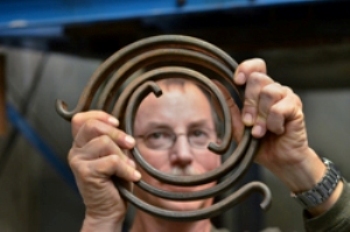Polycrystalline diamond compact (PDC) bits were developed 30 years ago for reducing the expenditure related to geothermal drilling. However, PDCs were initially used for oil and gas drilling as they were comparatively less complicated.
 Elton Wright shows a torsional spring that’s used to simulate the rotational vibration of the drill string in a Sandia experiment. (Photo by Randy Montoya)
Elton Wright shows a torsional spring that’s used to simulate the rotational vibration of the drill string in a Sandia experiment. (Photo by Randy Montoya)
Geothermal drilling involves higher temperatures and harder, fractured rock. It is usually done in metamorphic and igneous rocks, which contain quartz and other abrasives, which cause accelerated wear of the drill bits. The fractured nature of the rock causes more damage due to the variations in impact loading.
Sandia has been involved in the development of PDC technology for geothermal drilling for over thirty years and it has received funding under the American Recovery and Reinvestment Act (ARRA) to further develop these PDC bits. The U.S. Navy and Sandia have demonstrated how the original PDC technology along with further improvements may be used for geothermal drilling. They conducted the testing in Imperial Valley, California at the Chocolate Mountains Aerial Gunnery Range. They drilled 1,291 ft. of a 3,000 ft. well using two PDC bits. The bits penetrated at an average speed of around 30 ft/hr for over four days. They performed better than typical roller bits.
Sandia partnered with National Oilwell Varco (NOV) of Houston, Barbour Well, Prime Core Systems and Prospect Geotech in the first phase of the demonstration tests.
The Department of Energy (DOE) aims to drill to depths of up to 30,000 ft. to access heat for geothermal energy. It has entered into a memorandum of understanding (MoU) with the Department of Defense for developing renewable energy resources. The present collaboration between Sandia and the Navy is covered by this MoU.
Sandia will partner with NOV to improve the materials and design of the bits in the second phase of this ARRA funded project.
Source: http://www.sandia.gov/